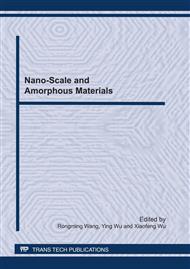p.127
p.135
p.141
p.148
p.153
p.158
p.162
p.168
p.175
Mg(OH)2 Crystals Synthesized by CHM Method
Abstract:
Using Mg(NO3)2·6H2O as raw materials, Mg(OH)2 crystals were synthesized by a composite-hydroxide-mediated(CHM) method at 160-200 °C for 24 h. Hexagonal plates Mg(OH)2 crystal were formed at high content of magnesium nitrate. The size of the plates increased to 5-15 μm while the content of magnesium nitrate was 30 mmol. The strength of (001) plane became stronger than (101) plane with the high content of magnesium nitrate, and this tendency became more obvious at high magnesium nitrate concentration. It is explained that the more Mg2+ ion fill the polar plane. The strength of (001) plane became stronger than (101) plane at high temperature. It can be explained Mg(OH)2 crystal become more steady with more non-polar plane at high temperature, and the shape of the sample showed a change from irregular to cubic shape with heated temperature increase. It indicates that the Mg(OH)2 crystal growth benefits from high temperature. It is conjectured that the connecting of the [Mg(OH)6]4+ basic units with the common edges change into common vertex angle.
Info:
Periodical:
Pages:
153-157
Citation:
Online since:
June 2011
Authors:
Keywords:
Price:
Сopyright:
© 2011 Trans Tech Publications Ltd. All Rights Reserved
Share:
Citation:


